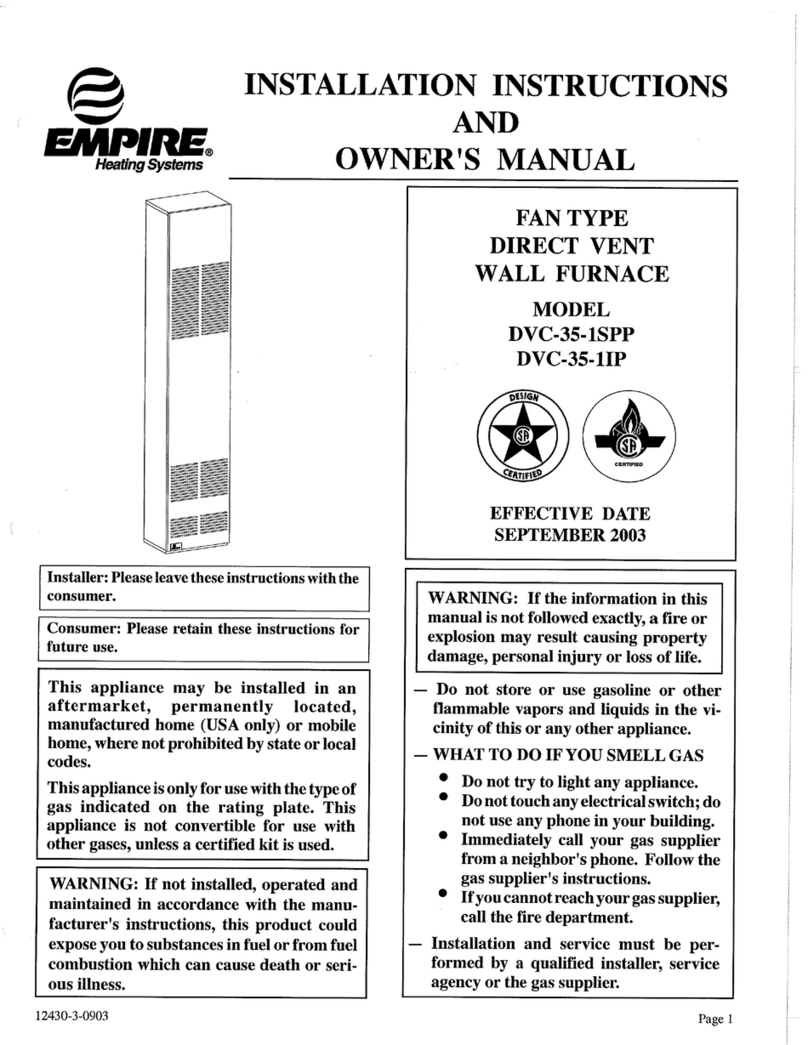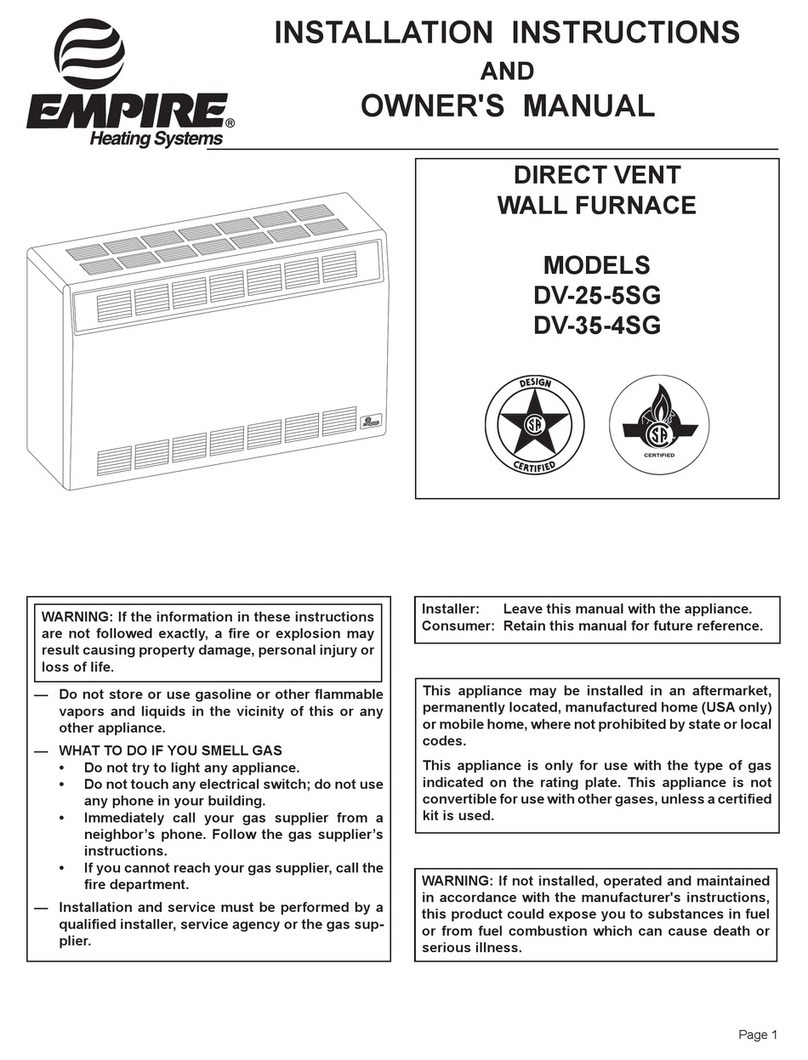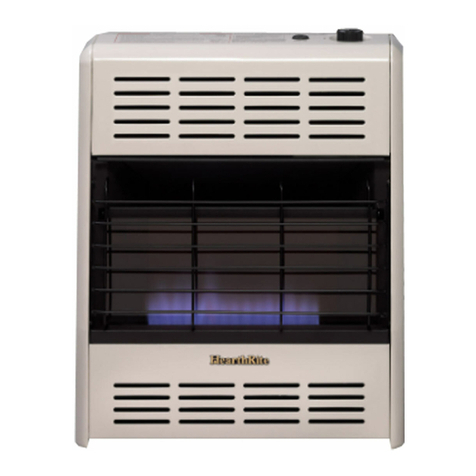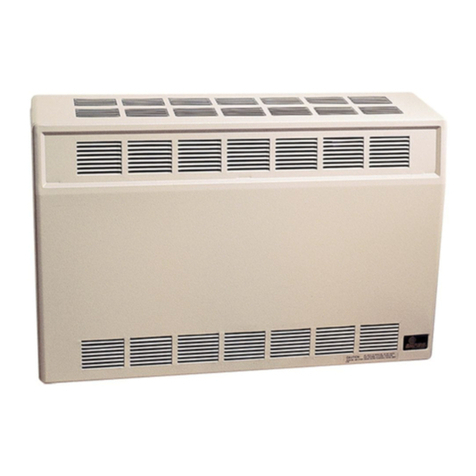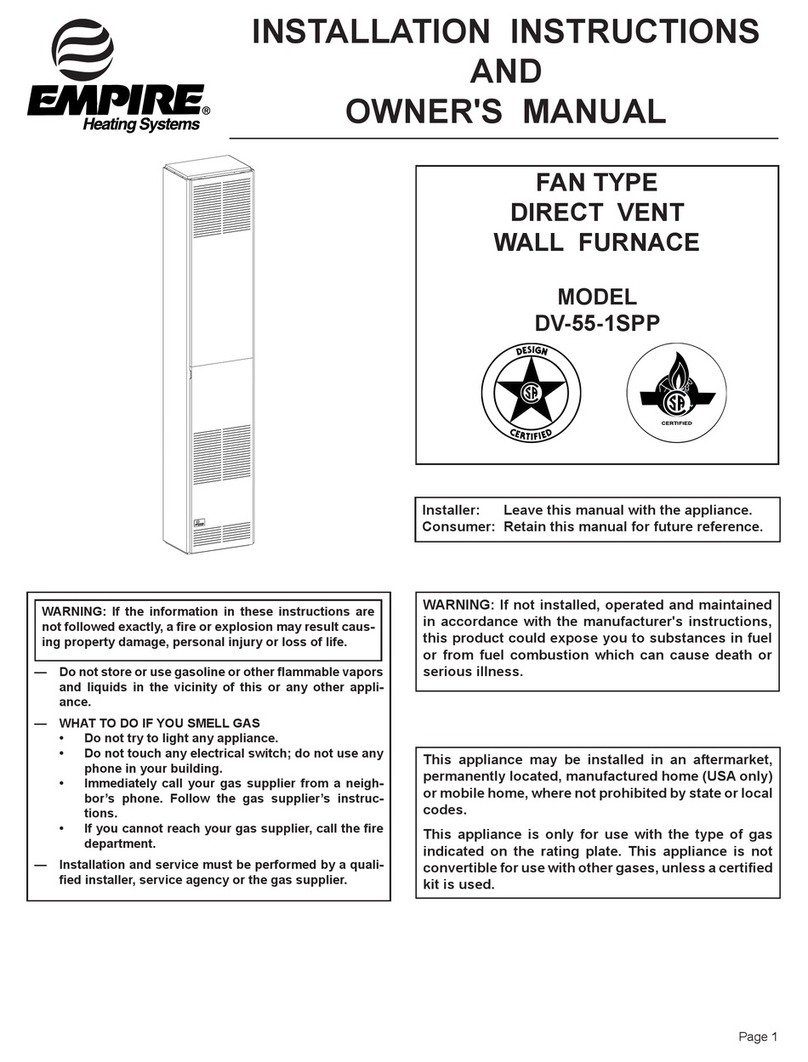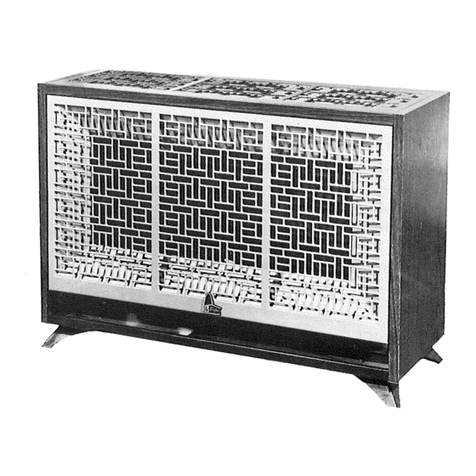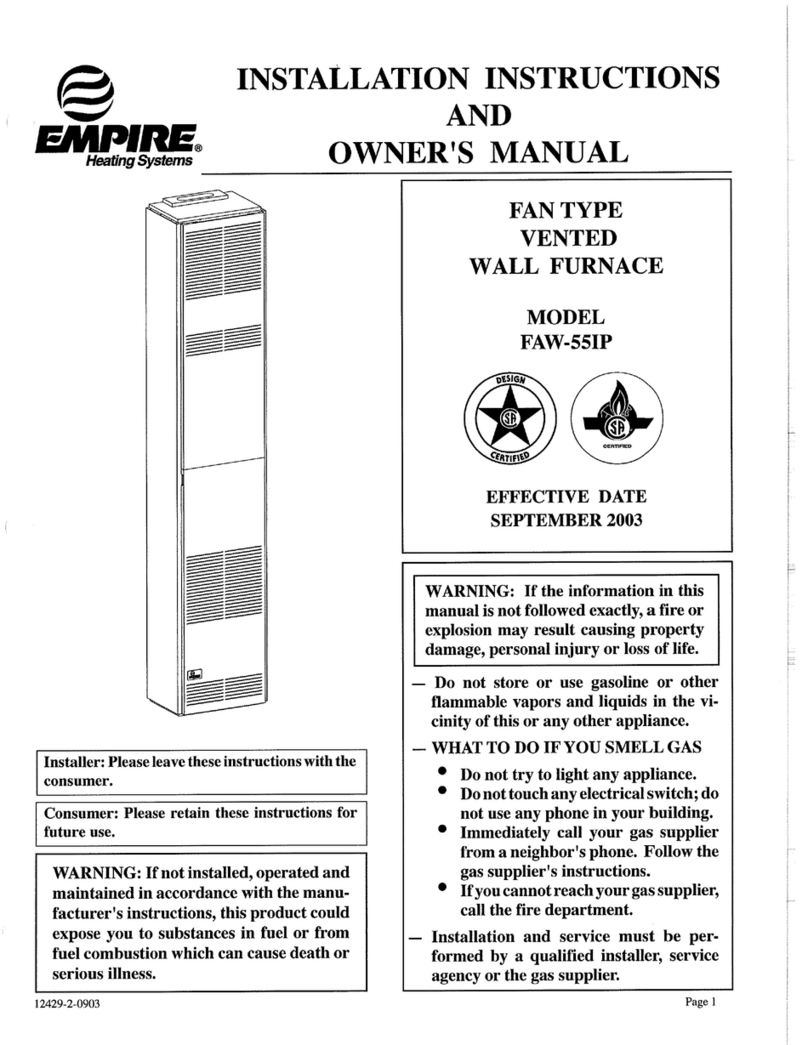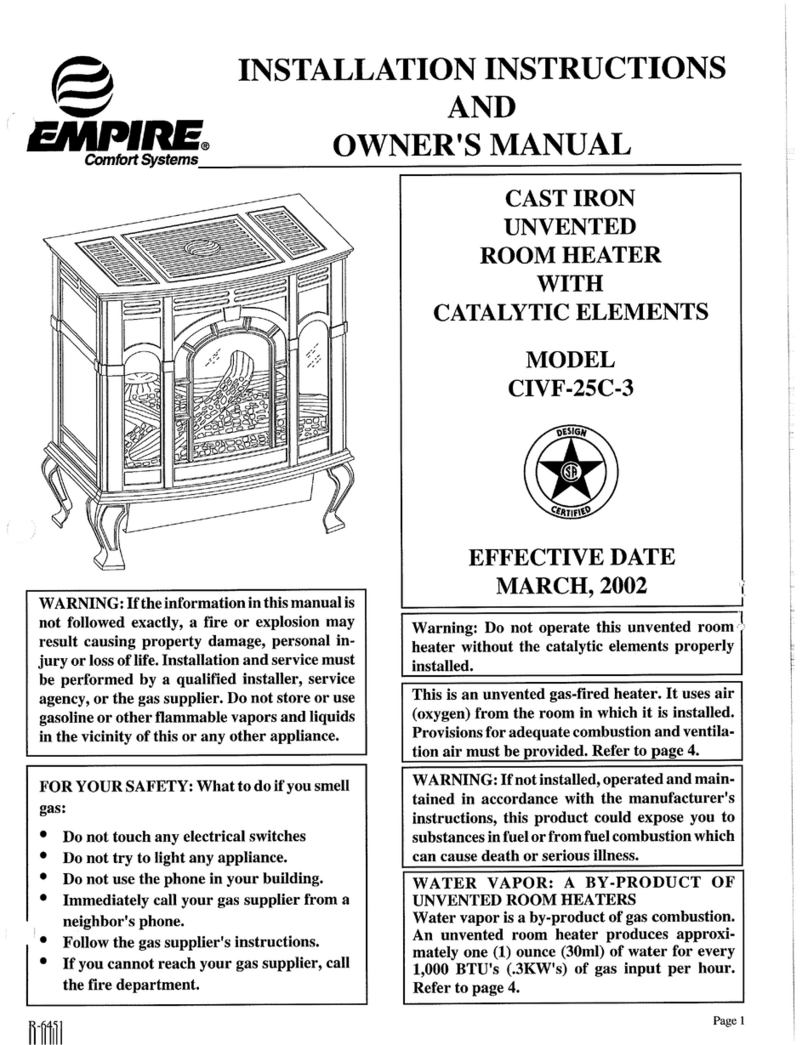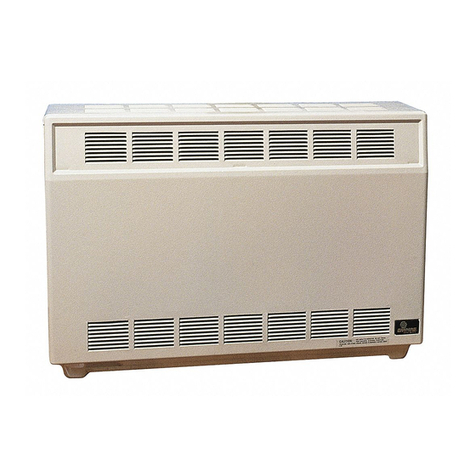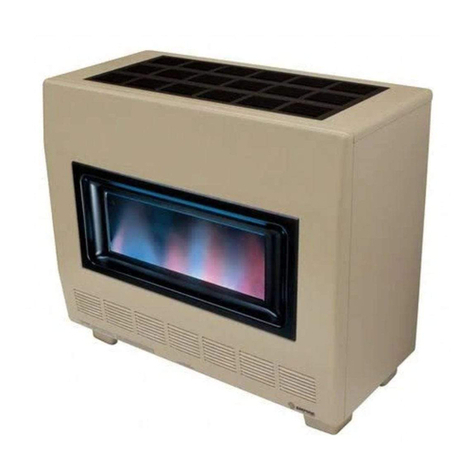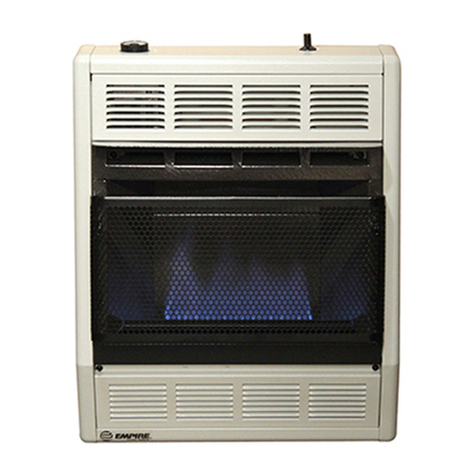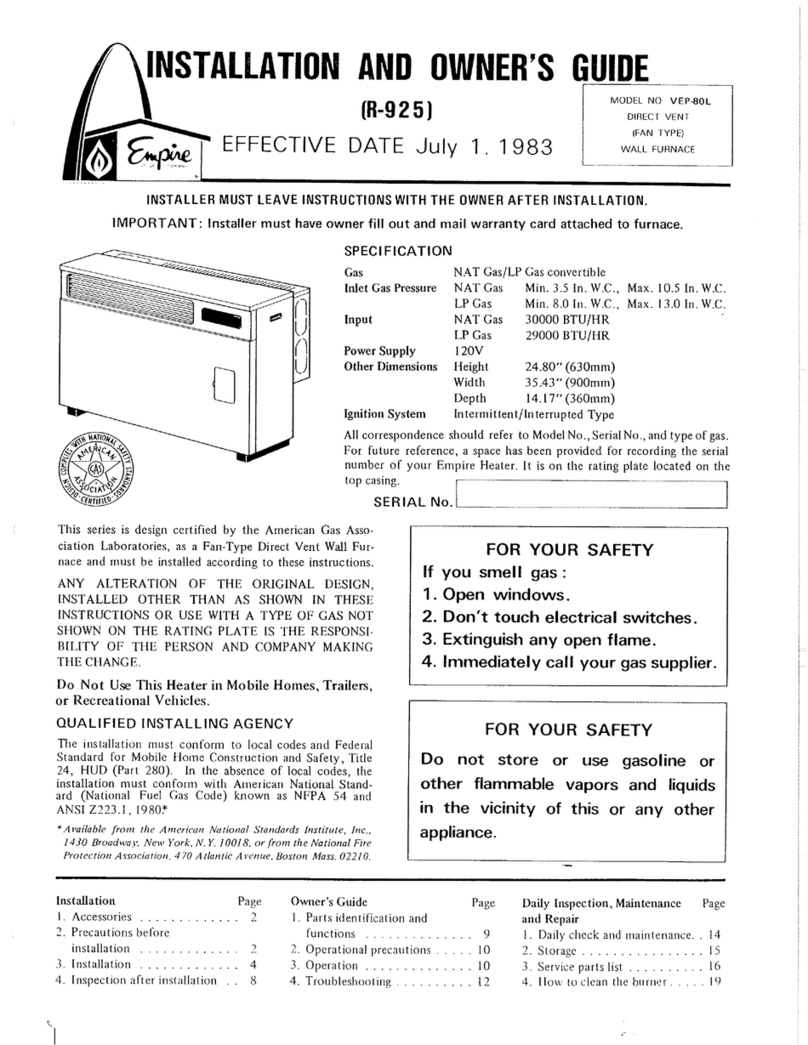
Page 4 R-5210
Introduction
Always consult your local Building Department regarding regulations,
codesor ordinances whichapplyto the installationofan unvented room
heater.
This appliance may be installed in an aftermarket* permanently located,
manufactured (mobile) home, where not prohibited by state or local
codes.
*Aftermarket: Completion of sale, not for purpose of resale, from the
manufacturer.
This appliance is only for use with the type of gas indicated on the rating
plate. This appliance is not convertible for use with other gases.
Instructions to Installer
1. Installermustleaveinstructionmanualwithownerafterinstallation.
2. Installer must have owner fill out and mail warranty card supplied
with unvented room heater.
3. Installershouldshow owner howtostartandoperateunventedroom
heater.
THIS IS A HEATING APPLIANCE
DO NOT OPERATE THIS APPLIANCE
WITHOUT FRONT PANEL INSTALLED.
WARNING: ANY CHANGE TO THIS HEATER OR ITS
CONTROLS CAN BE DANGEROUS.
Any safety screen or guard removed for servicing an appliance
must be replaced prior to operating the heater.
General Information
ThisapplianceisdesigncertifiedinaccordancewithAmericanNational
StandardsInstituteZ21.11.2b-1998bytheCanadianStandardsAssocia-
tion Laboratories as an Unvented Room Heater and shall be installed
according to these instructions.
Any alteration of the original design, installed other than as shown
intheseinstructionsorusewithatypeofgasnotshownontherating
plate is the responsibility of the person and company making the
change.
Important
All correspondence should refer to complete Model Number, Serial
Number and type of gas.
Well Head Gas Installations
Some natural gas utilities use "well head" gas. This may affect the Btu
output of the unit. Contact the gas company for the heating value.
Contact the manufacturer or your gas company before changing spud/
orifice size.
Qualified Installing Agency
Installation and replacement of gas piping, gas utilization equipment or
accessoriesandrepairandservicingofequipmentshallbeperformedonly
bya qualifiedagency. Theterm"qualifiedagency"meansanyindividual,
firm,corporation,orcompanythateitherin person or through arepresen-
tative is engaged in and is responsible for (a) the installation, testing, or
replacement of gas piping or (b) the connection, installation, testing,
repair, or servicing of equipment; that is experienced in such work; that
isfamiliarwithallprecautionsrequired,andthathascompliedwithallthe
requirements of the authority having jurisdiction.
Theinstallation mustconform with localcodes or, inthe absenceof local
codes, with the National Fuel Gas Code, ANSI Z223.1 (latest edition).*
*Available from the American National Standards Institute, Inc., 11 West 42nd St., New
York, N.Y. 10036.
Water Vapor: A By-Product of Unvented Room Heaters
Water vapor is a by-product of gas combustion. An unvented room
heater produces approximately one (1) ounce (30ml) of water for every
1,000 BTU's (.3KW's) of gas input per hour.
Unvented room heaters are recommended as supplemental heat (a room)
ratherthanaprimaryheatsource(anentirehouse). Inmostsupplemental
heat applications, the water vapor does not create a problem. In most
applications, the water vapor enhances the low humidity atmosphere
experienced during cold weather.
The following steps will help insure that water vapor does not become a
problem.
1. Be sure the heater is sized properly for the application, including
ample combustion air and circulation air.
2. If high humidity is experienced, a dehumidifier may be used to help
lower the water vapor content of the air.
3. Do not use an unvented room heater as the primary heat source.
Provisions for Adequate Combustion and Ventilation Air
This heater shall not be installed in a confined space or unusually tight
constructionunless provisionsareprovidedforadequatecombustionand
ventilation air.
The National Fuel Gas Code, ANSI Z223.1 defines a confined space as a
space whose volume is less than 50 cubic feet per 1,000 Btu per hour
(4.8m3per kw) of the aggregate input rating of all appliances installed in
that space and an unconfined space as a space whose volume is not less
than 50 cubic feet per 1,000 Btu per hour (4.8m3per kw) of the aggregate
inputratingofallappliancesinstalledinthatspace. Roomscommunicat-
ing directly with the space in which the appliances are installed, through
openingsnotfurnishedwithdoors,areconsideredapartoftheunconfined
space.
The following example is for determining the volume of a typical area in
which the SR-30T may be located and for determining if this area fits the
definition of an unconfined space.
The input of the SR-30T is 30,000 Btu per hour. Based on the 50 cubic
feet per 1,000 Btu per hour formula, the minimum area that is an
unconfined space for installation of the SR-30T is 1,500 cubic feet, 50
cubic feet x 30 = 1,500 cubic feet. To determine the cubic feet of the area
in which the SR-30T is to be installed, measure the length, width and
heightof thearea. Example: The areameasures 16feet inlength, 12feet
inwidthand8feetinheight,theareais1,536cubicfeet. The SR-30T can
be installed in this unconfined space with no requirement to provide
additional combustion and ventilation air.
Warning: If the areain whichthe heater maybe operated is smaller than
thatdefined as anunconfinedspace orifthe building isof unusually tight
construction, provide adequate combustion and ventilation air by one of
the methods described in the National Fuel Gas Code, ANSI Z223.1,
Section 5.3 or applicable local codes.
Unusually Tight Construction
The air that leaks around doors and windows may provide enough fresh
air for combustion and ventilation. However, in buildings of unusually
tight construction, you must provide additional fresh air.
Unusually tight construction is defined as construction where:
a. Walls and ceilings exposed to the outside atmosphere have a
continuous water vapor retarder with a rating of one perm or less
with openings gasketed or sealed, and
b. Weatherstripping has been added on openable windows and
doors, and
c. Caulking or sealants are applied to areas such as joints around
windowanddoorframes,betweensoleplatesandfloors,between
wall-ceilingjoints,betweenwallpanels,atpenetrationsforplumb-
ing, electrical, and gas lines, and at other openings.
If the SR-30T heater is installed in a building of unusually tight
construction, adequate air for combustion, ventilation and dilution of
fluegases shall beprovided inaccordancewith ANSIZ223.1/NFPA54.
